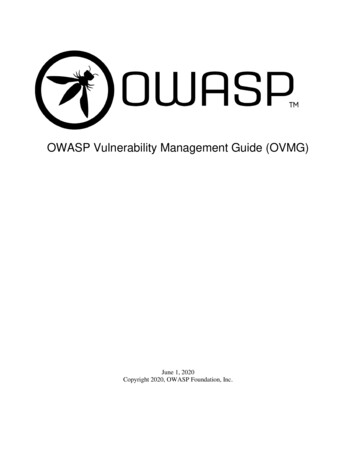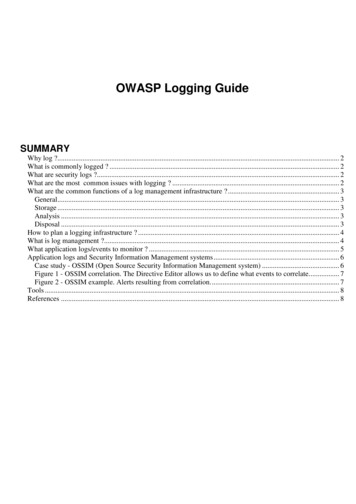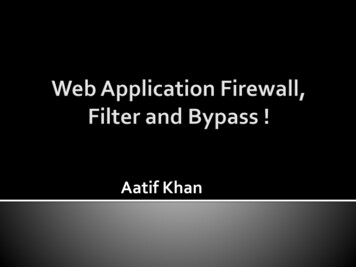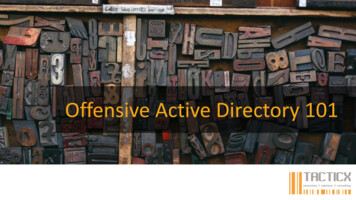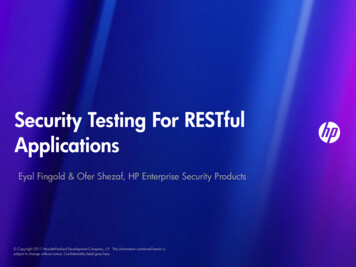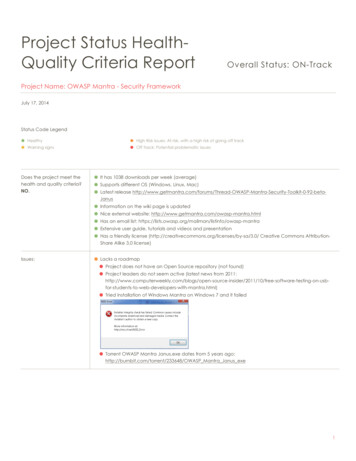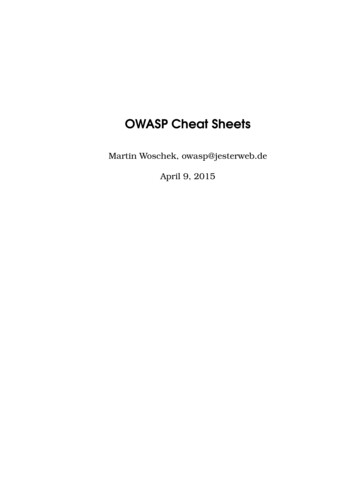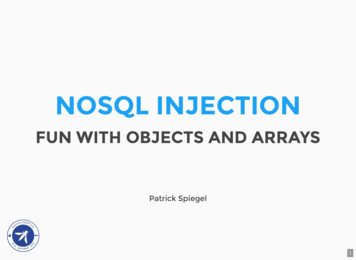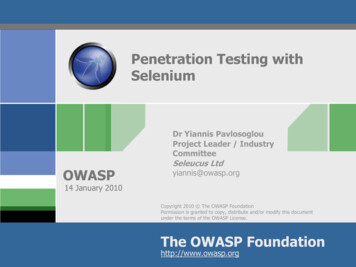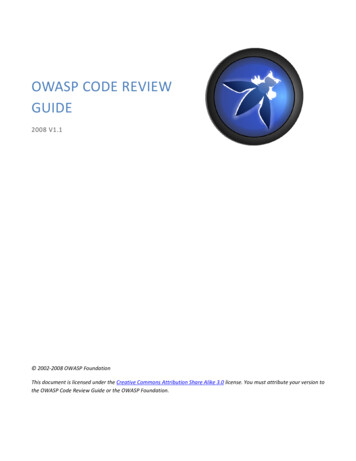
Transcription
OWASP CODE REVIEWGUIDE2008 V1.1 2002-2008 OWASP FoundationThis document is licensed under the Creative Commons Attribution Share Alike 3.0 license. You must attribute your version tothe OWASP Code Review Guide or the OWASP Foundation.
OWASP Code Review Guide V1.1 2008Table of ContentsForeword by Jeff Williams, OWASP Chair . 4Welcome to the OWASP Code Review Guide 1.1 . 6About The Open Web Application Security Project . 8Code Review Guide History . 10Introduction . 11Preparation . 13Security Code Review in the SDLC . 16Security Code Review Coverage . 18Application Threat Modeling . 22Code Review Metrics . 45Crawling code . 49Searching for code in J2EE/Java . 56Searching for code in Classic ASP. 60Javascript / Web 2.0 keywords and pointers . 63Code review and PCI DSS . 64Reviewing by technical control: Authentication . 66Reviewing by technical control: Authorization . 73Reviewing by technical control: Session Management . 78Reviewing by technical control: Input Validation . 81Reviewing by technical control: Error Handling. 83Reviewing by technical control Secure application deployment . 95Reviewing by technical control Cryptographic controls . 99Reviewing Code for Buffer Overruns and Overflows . 1122
OWASP Code Review Guide V1.1 2008Reviewing Code for OS Injection . 117Reviewing Code for SQL Injection . 121Reviewing Code for Data Validation . 127Reviewing Code for Cross-site scripting. 141Reviewing code for Cross-Site Request Forgery issues . 148Reviewing Code for Logging Issues . 153Reviewing Code for Session Integrity issues . 158Reviewing Code for Race Conditions . 161Additional security considerations: . 163Java gotchas . 164Java leading security practice . 170Classic ASP Design Mistakes . 173PHP Security Leading Practice . 177Strings and Integers . 180Reviewing MySQL Security . 184Reviewing Flash Applications . 187Reviewing Web services . 190How to write an application code review finding . 192Automated Code revieW . 195Tool Deployment Model . 196The Owasp Orizon Framework . 197The Owasp Code Review Top 9. 208Guide References . 2163
OWASP Code Review Guide V1.1 2008FOREWORD BY JEFF WILLIAMS, OWASP CHAIRMany organizations have realized that their code is not as secure as they may have thought. Now they're starting thedifficult work of verifying the security of their applications.There are four basic techniques for analyzing the security of a software application - automated scanning, manualpenetration testing, static analysis, and manual code review. This OWASP Guide is focused on the last of these techniques.Of course, all of these techniques have their strengths, weaknesses, sweet spots, and blind spots. Arguments about whichtechnique is the best are like arguing whether a hammer or saw is more valuable when building a house. If you try to build ahouse with just a hammer, you'll do a terrible job. More important than the tool is probably the person holding thehammer anyway.The OWASP guides are intended to teach you how to use these techniques. But the fact that they are separate shouldn't bean indicator that they should be used alone. The Development Guide shows your project how to architect and build asecure application, this Code Review Guide tells you how to verify the security of your application's source code, and theTesting Guide shows you how to verify the security of your running application.Security moves too fast for traditional books to be of much use. But OWASP's collaborative environment allows us to keepup to date. There are hundreds of contributors to the OWASP Guides, and we make over a thousand updates to ourmaterials every month. We're committed to making high quality application security materials available to everyone. It'sthe only way we'll ever make any real progress on application security as a software community.Why Code Review?I've been performing security code reviews (along with the other techniques) since 1998, and I've found thousands ofserious vulnerabilities. In my experience, design documentation, code comments, and even developers themselves areoften misleading. The code doesn't lie. Actually, the code is your only advantage over the hackers. Don't give up thisadvantage and rely only on external penetration testing. Use the code.Despite the many claims that code review is too expensive or time consuming, there is no question that it is the fastest andmost accurate way to find and diagnose many security problems. There are also dozens of serious security problems thatsimply can't be found any other way. I can't emphasize the cost-effectiveness of security code review enough. Considerwhich of the approaches will identify the largest amount of the most significant security issues in your application, andsecurity code review quickly becomes the obvious choice. This applies no matter what amount of money you can apply tothe challenge.Every application is different; that's why I believe it's important to empower the individuals verifying security to use themost cost-effective techniques available. One common pattern is to use security code review to find a problem, andpenetration testing to prove that it is exploitable. Another pattern is finding a potential issue with penetration testing, andthen verifying the issue by finding and examining the code. I strongly believe that the "combined" approach is the bestchoice for most applications.Getting StartedIt's important to recognize that code is a rich expressive language that can be used to build anything. Analyzing arbitrarycode is a difficult job that requires a lot of context. It's a lot like searching a legal contract for loopholes. So while it mayseem tempting to rely on an automated tool that simply finds security holes, it's important to realize that these tools are4
OWASP Code Review Guide V1.1 2008more like spell-checkers or grammar-checkers. While important, they don't understand the context, and miss manyimportant security issues. Still, running tools is a great way to gather data that you can use in your code review.All you need to get started is a copy of the software baseline, a modern IDE, and the ability to think about the ways securityholes get created. I strongly recommend that before you look at any code, you think hard about what is most important toyour application. Then you verify that the security mechanisms are present, free from flaws, and properly used. You'll tracethrough the control and data flows in the application, thinking about what might go wrong.Call to ActionIf you're building software, I strongly encourage you to get familiar with the security guidance in this document. If you finderrors, please add a note to the discussion page or make the change yourself. You'll be helping thousands of others who usethis guide.Please consider joining us as an individual or corporate member so that we can continue to produce materials like this codereview guide and all the other great projects at OWASP.Thank you to all the past and future contributors to this guide, your work will help to make applications worldwide moresecure.-- Jeff Williams, OWASP Chair, October 17, 20075
OWASP Code Review Guide V1.1 2008WELCOME TO THE OWASP CODE REVIEW GUIDE 1.1“my children, the internet is broken, can we fix this mess?”-- Eoin Keary, OWASP Code Review Guide Lead Author & EditorOWASP thanks the authors, reviewers, and editors for their hard work in bringing this guide to where it is today. If you haveany comments or suggestions on the Code review Guide, please e-mail the Code review Guide mail p-codereviewCOPYRIGHT AND LICENSECopyright (c) 2
security code review quickly becomes the obvious choice. This applies no matter what amount of money you can apply to the challenge. Every application is different; that's why I believe it's important to empower the individuals verifying security to use the most cost-effective techniques available. One common pattern is to use security code review to find a problem, and penetration testing to .
